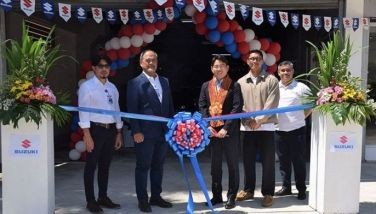Cocodiesel anyone?
October 17, 2001 | 12:00am
Believe it or not, but for several years now a number of vehicles in the country have been running around not on gasoline, not on the typical diesel, but on a new concoction from coconut oil.
And these vehicles are from the Philippine Coconut Authority (PCA) which is testing its new fuel – the cocodiesel.
The feat has been the result of researches undertaken over the past decade in the government’s effort to replace petroleum diesel by cocodiesel in order to save precious dollars.
"The PCA’s tests on automobile run by cocodiesel for years have demonstrated very high satisfactory results," the PCA reported.
Cocodiesel is known among scientiests as coconut methyl ester (CME). It is a diesel substitute derived from coconut oil. It is produced using transesterification, a process that involves the reaction of coconut oil and other triglycerides (animal/vegetable oil) with methanol under high temperature and using catalysts to produce alcohol or ester and glycerol.
Transesterification allows production by volume and the resulting primary product can match commercial diesel fuel.
Glycerol, the high-value by-product, is a syrupy liquid with a sweet taste. It is used as solvent, plasticizer, emollient, humectant, and raw material in the manufacture of nitroglycerin for the explosive industry and in cosmetics, liquid soap, liqueurs, confectionery, and lubricants.
As early as April 1991, several government agencies, particularly those involved in science and technology, had agreed to pool their resources, expertise, and facilities on a project that would determine the viability of using cocodiesel on motor vehicles.
These agencies were the PCA, the Department of Science and Technology, the DOST’s Industrial and Technology Development Institute, the National Power Corporation, and the Philippine National Oil Company.
Their studies showed that it was technically viable to use cocodiesel as substitute for petroleum diesel.
However, further studies indicated that the production of cocodiesel was not yet economically viable due to the high cost of raw materials. Also, cocodiesel production can only be viable in areas where diesel is being sold at a high price and where copra, or dried coconut shells, can be produced at a low cost.
Another study on cocodiesel processing and utilization tackled Cruzesterification Technology which was proposed by Dr. Rico Cruz. The technology claimed that the cocodiesel production process does not require the addition of heat, fuel sweetening or washing, and that no sophisticated equipment would be needed. In short, virtually anybody can make cocodiesel.
The Cruzesterification Technology was evaluated to be simply a batch-type process of producing crude cocodiesel. However, the resulting product did not pass the physico-chemical specifications of commercial petroleum diesel based on some test standards, among them the American Society for Testing and Materials.
In 1991, too, the Philippine Coconut Research and Development Foundation (PCRDF) began studying the comparative performance of 100-percent cocodiesel as substitute for diesel fuel.
The project was conceptualized, initiated, and implemented after an observation trip in Malaysia by PCRDF officials. Malaysia was then conducting its Biofuel Program using palm oil methyl esters.
The PCRDF experiment utilized an AUV vehicle which finished the targeted 100,000-kilometer road testing with very satisfactory findings.
The project, which came to be known as the Technology Transfer of Cocodiesel and Methyl Ester in Region XI, was also initiated in line with the government’s thrust to discover and promote alternative fuels. Region XI or Southern Mindanao was chosen because it is home to one-third of the country’s coconut plantations and produces 50 percent of the country’s coconut oil. Aside from these factors, the region was an easy choice because it is one of the few places in the country where petroleum diesel is expensive.
Coordinated by the DOST’s Philippine Council for Industrial and Energy Research and Development, the project was implemented by JVA Management Corp. through the Davie Fruits, Hijo Plantation and Twin Plantation in Tagum, Davao del Norte, in cooperation with the University of the Philippines-College of Engineering, ITDI, and Resins, Inc.
The project started in March 1991 and went on for six months.
In many of the scientific studies, the PCA noted that cocodiesel has been proven viable to match petroleum diesel in terms of engine performance and lifespan. It also cited the new fuel’s advantages.
• There is no need for oil well, pipeline, or supertankers.
•It is a renewable resource.
• It helps conserve resources.
• It creates new market opportunities for farmers.
•It has valuable by-products (glycerin and organic fertilizers).
•It can be used in any conventional diesel engine.
• It can be used pure or in a mixture with petroleum fuels.
•Environmentally, it has the following benefits:
• It has a close carbon dioxide cycle and a wide range of sustainable application.
•It does not add to the world’s carbon monoxide emission and greenhouse effect.
•It burns cleaner and minimizes the addition of volatile compounds in at atmosphere.
• It has negligible sulfur content.
•Exhaust gas is free of lead, sulfur dioxide, and halogens.
•There is substantial reduction of soot, unburned hydrocarbons, and of carbon monoxide in the exhaust gases.
And these vehicles are from the Philippine Coconut Authority (PCA) which is testing its new fuel – the cocodiesel.
The feat has been the result of researches undertaken over the past decade in the government’s effort to replace petroleum diesel by cocodiesel in order to save precious dollars.
"The PCA’s tests on automobile run by cocodiesel for years have demonstrated very high satisfactory results," the PCA reported.
Cocodiesel is known among scientiests as coconut methyl ester (CME). It is a diesel substitute derived from coconut oil. It is produced using transesterification, a process that involves the reaction of coconut oil and other triglycerides (animal/vegetable oil) with methanol under high temperature and using catalysts to produce alcohol or ester and glycerol.
Transesterification allows production by volume and the resulting primary product can match commercial diesel fuel.
Glycerol, the high-value by-product, is a syrupy liquid with a sweet taste. It is used as solvent, plasticizer, emollient, humectant, and raw material in the manufacture of nitroglycerin for the explosive industry and in cosmetics, liquid soap, liqueurs, confectionery, and lubricants.
As early as April 1991, several government agencies, particularly those involved in science and technology, had agreed to pool their resources, expertise, and facilities on a project that would determine the viability of using cocodiesel on motor vehicles.
These agencies were the PCA, the Department of Science and Technology, the DOST’s Industrial and Technology Development Institute, the National Power Corporation, and the Philippine National Oil Company.
Their studies showed that it was technically viable to use cocodiesel as substitute for petroleum diesel.
However, further studies indicated that the production of cocodiesel was not yet economically viable due to the high cost of raw materials. Also, cocodiesel production can only be viable in areas where diesel is being sold at a high price and where copra, or dried coconut shells, can be produced at a low cost.
Another study on cocodiesel processing and utilization tackled Cruzesterification Technology which was proposed by Dr. Rico Cruz. The technology claimed that the cocodiesel production process does not require the addition of heat, fuel sweetening or washing, and that no sophisticated equipment would be needed. In short, virtually anybody can make cocodiesel.
The Cruzesterification Technology was evaluated to be simply a batch-type process of producing crude cocodiesel. However, the resulting product did not pass the physico-chemical specifications of commercial petroleum diesel based on some test standards, among them the American Society for Testing and Materials.
In 1991, too, the Philippine Coconut Research and Development Foundation (PCRDF) began studying the comparative performance of 100-percent cocodiesel as substitute for diesel fuel.
The project was conceptualized, initiated, and implemented after an observation trip in Malaysia by PCRDF officials. Malaysia was then conducting its Biofuel Program using palm oil methyl esters.
The PCRDF experiment utilized an AUV vehicle which finished the targeted 100,000-kilometer road testing with very satisfactory findings.
The project, which came to be known as the Technology Transfer of Cocodiesel and Methyl Ester in Region XI, was also initiated in line with the government’s thrust to discover and promote alternative fuels. Region XI or Southern Mindanao was chosen because it is home to one-third of the country’s coconut plantations and produces 50 percent of the country’s coconut oil. Aside from these factors, the region was an easy choice because it is one of the few places in the country where petroleum diesel is expensive.
Coordinated by the DOST’s Philippine Council for Industrial and Energy Research and Development, the project was implemented by JVA Management Corp. through the Davie Fruits, Hijo Plantation and Twin Plantation in Tagum, Davao del Norte, in cooperation with the University of the Philippines-College of Engineering, ITDI, and Resins, Inc.
The project started in March 1991 and went on for six months.
In many of the scientific studies, the PCA noted that cocodiesel has been proven viable to match petroleum diesel in terms of engine performance and lifespan. It also cited the new fuel’s advantages.
• There is no need for oil well, pipeline, or supertankers.
•It is a renewable resource.
• It helps conserve resources.
• It creates new market opportunities for farmers.
•It has valuable by-products (glycerin and organic fertilizers).
•It can be used in any conventional diesel engine.
• It can be used pure or in a mixture with petroleum fuels.
•Environmentally, it has the following benefits:
• It has a close carbon dioxide cycle and a wide range of sustainable application.
•It does not add to the world’s carbon monoxide emission and greenhouse effect.
•It burns cleaner and minimizes the addition of volatile compounds in at atmosphere.
• It has negligible sulfur content.
•Exhaust gas is free of lead, sulfur dioxide, and halogens.
•There is substantial reduction of soot, unburned hydrocarbons, and of carbon monoxide in the exhaust gases.
BrandSpace Articles
<
>
- Latest
Latest
Latest
April 8, 2025 - 5:00pm
April 8, 2025 - 5:00pm
March 11, 2025 - 11:00am
March 11, 2025 - 11:00am
February 10, 2025 - 2:30pm
February 10, 2025 - 2:30pm
February 6, 2025 - 4:36pm
February 6, 2025 - 4:36pm
Recommended


























